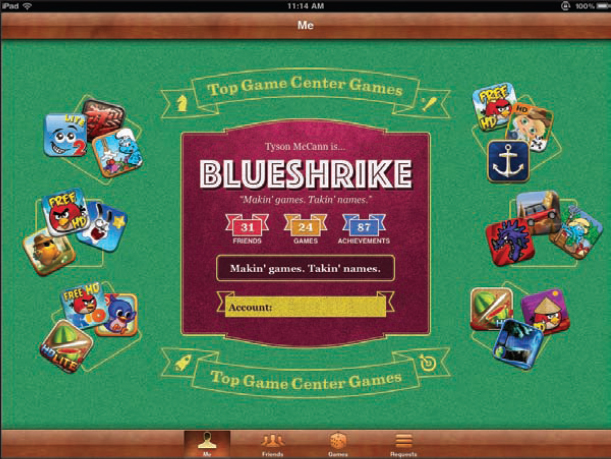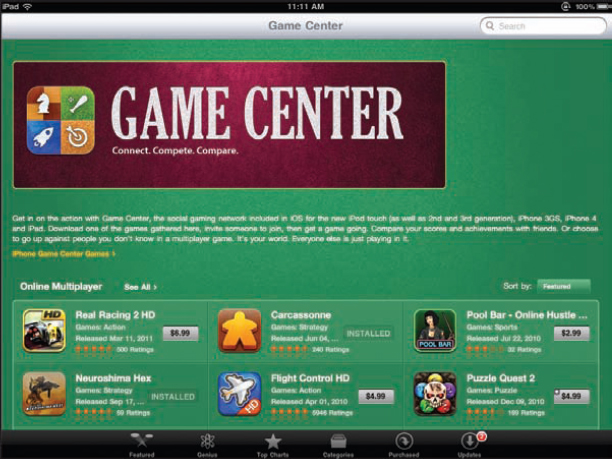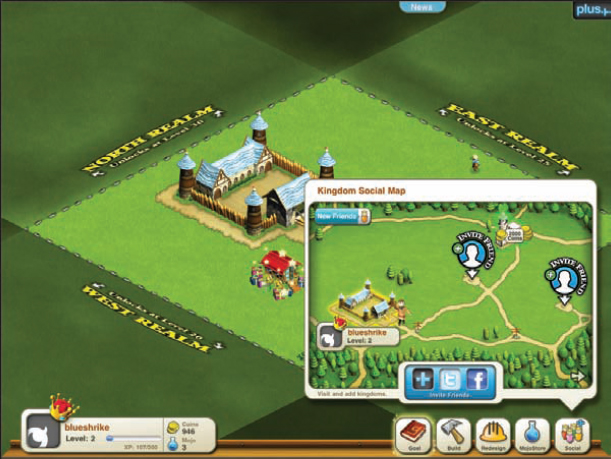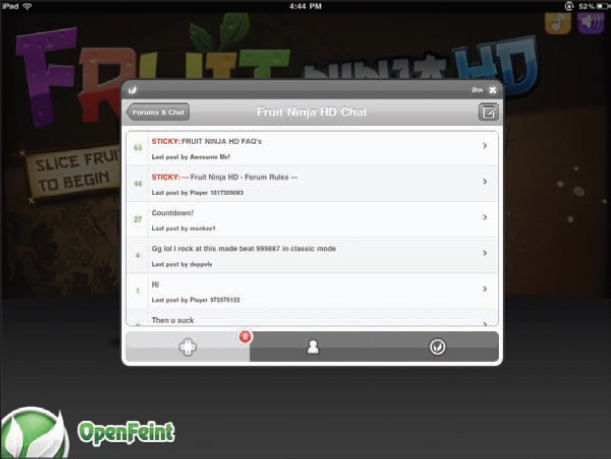FOSTERING THE ULTIMATE VIRAL MARKETING: SOCIAL NETWORKS
Two social networks dominate the current social media market: Facebook and Twitter. Because of the sheer number of users across all demographics, it is essential for any out-of-app marketing campaign to make use of these, and, when possible, to do so in-app as well.
At its core, viral marketing is any method of acquiring users that provides more than one additional user for every new user acquired. There was a catchy Faberge Shampoo television commercial in the 1980s that featured Heather Locklear saying, “It was so good I told two friends about it. And they told two friends. And so on, and so on…” — all while the screen was dividing up into smaller and smaller squares with new faces. Viral marketing is like that.
The good thing is that viral marketing doesn't completely depend on just one channel any more. In fact, to maximize those areas that are overachieving and to tweak areas that need improvement, it's good to utilize as many channels as you have the time and resources for. If you can utilize all your channels, and the end result is that your overall cost per new user (all social marketing costs including YouTube videos, websites, support, Facebook fan pages, Twitter campaigns, and so on) is less than their expected lifetime value or expenditure, then your campaigns are paying off, regardless of the viral component. The terms cost per user acquisition (CPA), customer acquisition cost (CAC), and lifetime value per customer (LTV) are most often used.
This book won't delve too deeply into metrics, because other books are available that can cover that subject in much better detail.
Integrating In-App Networks
Currently, the four largest in-app social networks (primarily for games) are Apple's Game Center, OpenFeint (www.openfeint.com), the Plus+ network (spoken as “plus plus,” at www.plusplus.com), and Facebook (putting a link here would be ridiculous). This section examines the benefits of using each, and why most games should consider using Game Center. Unfortunately, for apps, there is nothing like this yet, though you might expect Apple or a third party to be working on something that could more socially integrate all types of apps (game or non-game).
Game Center
In June 2011, Apple noted that 50 million users were using Game Center, the native social network that is integrated with all iOS apps post version 4.0. However, older iPhones and iPods (which aren't compatible with the newer iOS) won't be able to run it.
Game Center's primary appeal is that it offers in-game achievements across friends, one of the main incentives to drive retention in games (and, in the future, most likely many apps as well — achievement rewards for common tasks).
Game Center differs substantially from OpenFeint and Plus+ in a couple of key areas:
- Apart from being an API that users can implement with a game, Game Center is also a native iOS app (see Figure 10-1) that users can open and manage their friends on — out of the game — rather than a separate interface to manage friends that is called from within-game in OpenFeint and Plus+.

FIGURE 10-1: In Game Center, you manage your friends and games from within its own app
- Game Center currently provides much less social connectivity functionality while playing games, such as finding new friends or seeing what they are up to. However, Apple is evolving Game Center, and will no doubt improve this over time. In fact, for the app itself, iOS 5 brings a number of new changes, including the display of achievement notification banners, adding a profile picture, friend recommendations, and seeing what friends of friends are playing, among other things.
When deciding whether to use Game Center, you should consider some unique pros and cons.
Unique pros of Game Center include the following:
- All newer i-devices come with it by default.
- Apple continues to update and improve its social connectivity.
- Game Center has the most current active users (not including Facebook, which is mostly externally driven).
- Game Center includes an integrated search right within the App Store, which none of the competitors can match (see Figure 10-2).
- Game Center has auto matchmaking and excellent multiplayer support.
- Users can make purchases right from within Game Center (which is a big deal).

FIGURE 10-2: Game Center integrates with iTunes, giving it an edge over its competition
Unique cons of Game Center include the following:
- Apple is slow to implement social connectivity features within games themselves, other than typical multiplayer features.
- Communication outlets within the Game Center community are currently low. For example, there are no forums, and it has limited profile information, message, and search/find friend functionality, especially when waiting in lobbies to join games.
- It has limited to no current cross-platform gaming.
- Its visual appearance within an app is not currently integrated into the visual style of the app, which decreases immersion. Note that the other major social game networks have the same problem, and are in need of more re-theming possibilities.
To sum up, mainly because it is native to iOS, Game Center has great multiplayer support, and you should strongly consider it for games. But you may want to also consider adding another social networking capability (such as OpenFeint or Facebook) to supplement it for social connectivity reasons.
It is possible (or worthwhile) to use multiple social services within one game. However, keep in mind that more services aren't necessarily better. Requiring users to jump through the hoops of registering your app, or jumping from one service to another, can be a barrier to both entry and use. Nonetheless, this might be a good option in instances where you want to support Game Center, but need more social connectivity, such that as found in OpenFeint. Later versions of OpenFeint even have Game Center integration, so that users can share achievements over either platform.
Other cases where you can use multiple social platforms at the same time include the scenario of adding friends. In the world-building, free-to-play game “We Rule” by ngmoco shown in Figure 10-3, you can pull friends in from Twitter, Facebook, as well as Plus+, making it easy for users, depending on which platform they use most frequently. This type of integration also causes very little back and forth between platforms.

FIGURE 10-3: “We Rule” from ngmoco uses Plus+, Facebook, and Twitter
OpenFeint versus Plus+
The main differences between these two platforms is in the number of users (OpenFeint has more), social features, and implementation. For the most part, Plus+ is falling behind in the race, and because Game Center is becoming more popular and adding social features (slowly but surely), this book tends to recommend the OpenFeint platform over Plus+. Following are a couple of the important areas of consideration:
- Ease of use — Although Plus+ has a more traditional and colorful layout (as shown in Figure 10-4), it has fewer options, and so is somewhat easier for the user to navigate. On the other hand, as shown in Figure 10-5, the OpenFeint icons are numerous, and it is easier to get lost within the screens (though they do have a standard “back” navigation bar throughout, which you can use to cycle back to the main menu).
- Social integration — OpenFeint is clearly ahead of every competitor on this front, with live chat and messaging, forums, and Facebook and Twitter links for most everything, as shown in Figure 10-6. Because of this, you should use OpenFeint, though this is offset somewhat by the sheer number of games (many of which are not worthy of a download).

FIGURE 10-4: The Plus+ network uses an aesthetically pleasing layout that is easy to navigate
Because of its massive adoption, Facebook should be a part of your app in some way if possible, whether utilizing Facebook Connect (discussed later in this chapter) to be able to add friends, or being able to share achievements or post something to your wall. Non-game apps, of course, should rely on Facebook over any other platform, unless you have a specific social platform that relates better to your app, such as what YouVersion (www.youversion.com) does with the “Glo Bible” app (www.globible.com). In the end, it is possible for Facebook and other networks to co-exist peacefully.
FIGURE 10-5: Because of all the functionality in OpenFeint, users make heavy use of “back” button navigation

FIGURE 10-6: OpenFeint uses a custom, streamlined layout that contains a lot of functionality
Building Achievements, Medals, Badges, and Other Rewards
Game achievements are the cornerstone of user retention. They provide players with a sense of progression and goals over multiple sessions, and rewards for achievements can provide even further incentives to try to complete the game.
The best example of achievements found today in a social-like network is on the Xbox Live Arcade (XBLA) platform. Every retail game must feature 1,000 points worth of achievements, divvied up typically between 20 and 40 individual ones, some worth more points, and some less, depending on the developer's design.
Any user of XBLA can instantly (from within a game) call up a friend's achievements and compare. This is a huge incentive to compete. After this system was such a success, Sony implemented Trophies for its PlayStation Online Network, which hasn't had quite the success (mostly because of social implementation) as the XBLA counterpart.
Enter Game Center, OpenFeint, and Plus+. These networks are capitalizing on creating shared achievements between friends and across games, so that users can compare total points earned. If you have a game and are not yet using achievements or some sort of goal-based rewards, you probably should, even if it remains in your game-only network of friends, because it will help drive future retention and engagement.
The best way to create achievements is to spread out the time it takes to complete them, creating sets of achievements that can be earned fairly quickly, as well as those that take progressively longer and are more challenging to complete. You should even add achievements for the hardcore gamer that can only be earned with sweat and tears.
![]() In “Archetype,” the team created a set of in-game achievements named Titles, which were based off experience points. These could be seen as a badge while in the lobby and in games, and, in a way, represented your skill and devotion. There was also a complete set of medals that could be earned via gameplay in each game (for example, kill five enemies within seven seconds). Experience, in turn, was dependent on winning or losing, and medals earned. These ideas weren't new to the genre, but were required for the type of user to ensure longer retention. In addition, the “Archetype” website featured leaderboards, player profiles, and search functionality, so players could stay invested in their progress out of the app as well.
In “Archetype,” the team created a set of in-game achievements named Titles, which were based off experience points. These could be seen as a badge while in the lobby and in games, and, in a way, represented your skill and devotion. There was also a complete set of medals that could be earned via gameplay in each game (for example, kill five enemies within seven seconds). Experience, in turn, was dependent on winning or losing, and medals earned. These ideas weren't new to the genre, but were required for the type of user to ensure longer retention. In addition, the “Archetype” website featured leaderboards, player profiles, and search functionality, so players could stay invested in their progress out of the app as well.
Aside from bragging rights that most achievements provide, further incentivizing them can be a smart move to drive better long-term retention. Not every achievement needs to unlock something, but it provides further goals to aspire to. For example, in “Fruit Ninja” and “Fruit Ninja HD,” the game features not only Game Center and OpenFeint (tied together) achievements, but another set of in-game achievements that unlock various rewards, such as new swords or backgrounds, as shown in Figure 10-7.

FIGURE 10-7: Achievements in “Fruit Ninja” unlock various in-game rewards, which is great for incentivizing long-term retention
Now, let's take a look at the current king of social media, Facebook, and what developers can learn from Facebook's successful apps.

